The Data Center Cabling Market is estimated to be valued at USD 7.7 billion in 2025 and is projected to reach USD 18.1 billion by 2035, registering a compound annual growth rate (CAGR) of 8.9% over the forecast period.
The data center cabling market is projected to expand steadily, growing from USD 5.0 billion in 2020 to approximately USD 18.1 billion by 2035, an overall increase of USD 13.1 billion during the forecast period. Between 2020 and 2025, the market rises from USD 5.0 billion to USD 7.1 billion, reflecting early-stage adoption of structured cabling and high-performance fiber solutions, supported by hyperscale data center expansion, increasing cloud adoption, and enterprise digital transformation. Growth in this period is supported by upgrades in copper and fiber infrastructure, ensuring reliable data transmission for expanding workloads.
From 2026 to 2030, the market strengthens further, expanding from USD 7.7 billion to USD 11.8 billion, driven by the rising penetration of 5G, edge computing, and demand for higher bandwidth applications. Data centers invest heavily in advanced cabling systems capable of handling large-scale virtualization, artificial intelligence, and IoT-driven workloads. Between 2031 and 2035, the market accelerates into maturity, growing from USD 12.9 billion to USD 18.1 billion, as demand for ultra-high-speed connectivity and low-latency infrastructure intensifies. Fiber optic cabling emerges as the backbone for next-generation data centers, with increasing adoption of pre-terminated and modular cabling systems that reduce installation costs and enhance scalability. The market trajectory mirrors a technology adoption curve, beginning with traditional structured cabling, transitioning to advanced fiber systems, and ultimately consolidating into high-capacity, intelligent cabling networks designed for long-term adaptability. Overall, the growth of the data center cabling market is supported by rising internet traffic, ongoing migration toward hybrid cloud models, and the strategic need for energy-efficient and resilient cabling systems across both hyperscale and enterprise facilities.
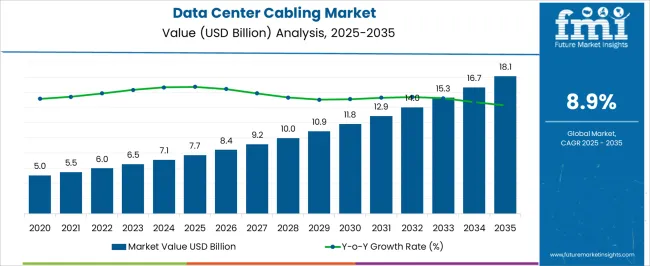
| Metric | Value |
|---|---|
| Data Center Cabling Market Estimated Value in (2025 E) | USD 7.7 billion |
| Data Center Cabling Market Forecast Value in (2035 F) | USD 18.1 billion |
| Forecast CAGR (2025 to 2035) | 8.9% |
The data center cabling market is witnessing rapid growth, driven by the increasing demand for high-speed data transmission and scalable network infrastructure. The rise of cloud computing, big data analytics, and edge computing has significantly increased the volume and complexity of data traffic, prompting upgrades to cabling systems that support higher bandwidth and lower latency.
Innovations in cable design and materials have improved performance and durability, making it easier for data centers to manage growing network loads efficiently. The expanding adoption of fiber optic technology has enhanced data transmission speeds and reliability over longer distances.
Investments in hyperscale and enterprise data centers, coupled with rising digital transformation initiatives, are expected to continue fueling market expansion. Segment growth is anticipated to be led by fiber optic cables as the preferred product type, the 6A wire category for its balance of performance and cost, and cables as the key component driving market revenue.
The data center cabling market is segmented by product, wire category, component, end use, application, and geographic regions. By product, the data center cabling market is divided into Fiber optic cables and Copper cables. In terms of the wire category, the data center cabling market is classified into 6A, 5E, 6, 7, and Others. Based on component, the data center cabling market is segmented into Cables, Connectors, Accessories, and Others. By end use, the data center cabling market is segmented into Hyperscale data centers, Colocation data centers, Enterprise data centers, and Cloud service providers. By application of the data center cabling market is segmented into Data transfer and networking, Power distribution, and Cable management and organization. Regionally, the data center cabling industry is classified into North America, Latin America, Western Europe, Eastern Europe, Balkan & Baltic Countries, Russia & Belarus, Central Asia, East Asia, South Asia & Pacific, and the Middle East & Africa.
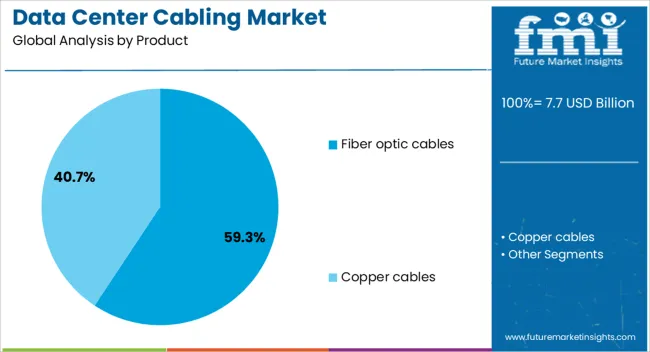
The fiber optic cables segment is projected to account for 59.3% of the data center cabling market revenue in 2025, retaining its leading position among product types. This growth is driven by fiber optics’ ability to deliver high bandwidth and low signal loss, meeting the demanding needs of modern data centers.
The superior performance of fiber optic cables in handling large data volumes and long-distance transmissions has made them the preferred choice over traditional copper cables. Fiber optics also offers advantages such as resistance to electromagnetic interference and enhanced security for sensitive data.
As data centers continue to scale and demand faster connections, fiber optic cables are expected to dominate the cabling market, supported by ongoing improvements in cable design and installation technologies.
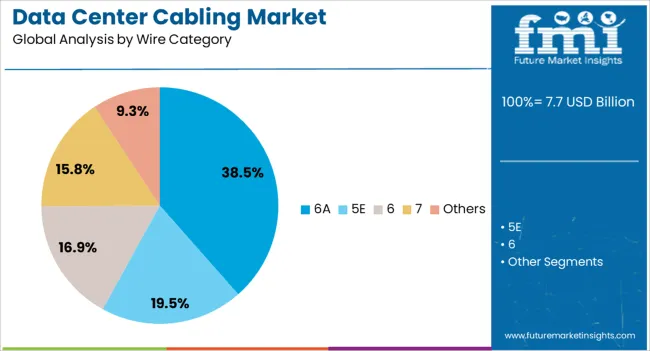
The 6A wire category is expected to hold 38.5% of the market share in 2025, maintaining its importance as a versatile and cost-effective solution. The 6A category supports high-speed data transmission up to 10 gigabits per second and offers improved alien crosstalk performance compared to lower categories.
This balance of high performance and cost efficiency has made it popular in data center environments where both speed and budget constraints are key considerations. The 6A wire’s compatibility with existing infrastructure and its suitability for shorter cable runs further contribute to its widespread adoption.
As network demands grow, the 6A segment will continue to be a reliable choice for many data center cabling needs.
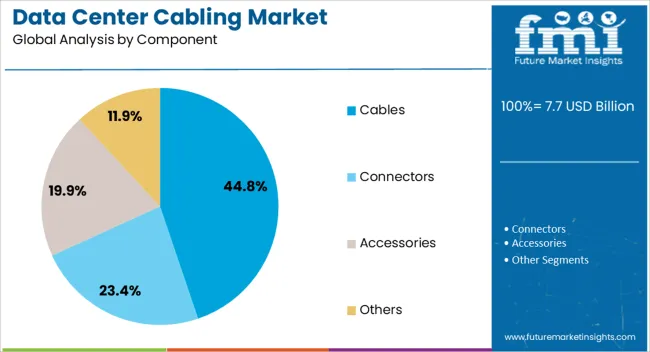
The cables component segment is projected to contribute 44.8% of the data center cabling market revenue in 2025, leading other component categories. This segment’s growth is driven by the core role cables play in interconnecting network devices and ensuring efficient data flow within data centers.
Quality and durability are critical factors influencing cable selection, as data centers require reliable connections that minimize downtime and maintenance. Advancements in cable jacket materials and shielding techniques have enhanced cable longevity and performance in demanding environments.
Furthermore, increasing deployment of modular and scalable data centers has heightened demand for flexible cabling solutions. The cables component segment is expected to maintain its market leadership due to its fundamental importance in data center infrastructure.
The data center cabling market is driven by hyperscale expansion, cloud and edge computing adoption, advancements in fiber and copper systems, and evolving standards. Together, these factors create a strong foundation for continued market growth.
The data center cabling market is witnessing notable growth due to the rapid expansion of hyperscale facilities. Operators are increasingly investing in advanced cabling solutions to accommodate massive data traffic generated by cloud platforms, streaming services, and enterprise applications. Fiber optic cabling dominates this segment because of its superior speed, reliability, and scalability compared to traditional copper systems. Hyperscale operators also prioritize modular cabling infrastructure that enables rapid deployment and efficient scalability in line with rising workloads. The adoption of high-density cabling architectures supports better airflow management and optimized space utilization. This surge in hyperscale projects worldwide continues to propel investments in innovative cabling systems that ensure seamless performance across large-scale operations.
Another key dynamic shaping the market is the increasing reliance on cloud computing and edge data centers. Organizations are embracing distributed computing models, which require low-latency cabling infrastructure to ensure consistent connectivity and responsiveness. Edge facilities depend on structured cabling systems that support both fiber and copper technologies for flexible deployments. Cloud providers are upgrading existing cabling infrastructure to handle bandwidth-intensive workloads, driven by artificial intelligence, big data, and IoT integration. The demand for cabling solutions that can ensure redundancy, low signal loss, and minimal downtime has expanded significantly. These trends have strengthened the importance of adaptable, pre-terminated cabling assemblies that reduce installation times and enhance overall reliability in diversified environments.
The cabling market is experiencing strong momentum with technological upgrades in both fiber and copper systems. Fiber optic cabling remains at the forefront due to its ability to transmit data at higher speeds with lower latency, supporting long-distance connectivity across global data centers. Meanwhile, copper cabling continues to evolve with new categories offering improved bandwidth and energy efficiency, making it suitable for short-range but high-performance applications. Manufacturers are also focusing on hybrid cabling designs that combine fiber’s speed with copper’s power delivery capabilities. These advancements address operator requirements for scalability, resilience, and cost efficiency, enabling organizations to optimize performance while keeping infrastructure adaptable to future networking demands.
Regulatory frameworks and cabling standards remain influential in driving market direction. International organizations and industry associations continuously update guidelines to ensure safety, performance, and compatibility of cabling infrastructure. Standards such as ANSI/TIA and ISO/IEC dictate installation practices, material quality, and testing protocols to guarantee consistent performance across global markets. Compliance with these standards helps operators achieve higher uptime and meet service-level agreements demanded by enterprises. Moreover, stricter energy efficiency and operational requirements have encouraged adoption of high-performance cabling systems that minimize signal degradation and optimize power usage. The role of standards is not only about regulatory compliance but also about creating a structured path for innovation and consistency across the cabling ecosystem.
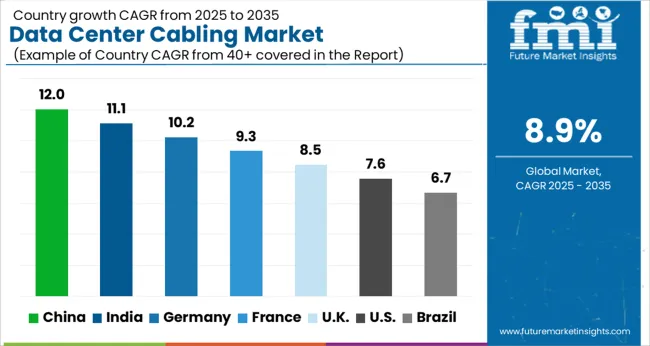
The data center cabling market is projected to grow globally at a CAGR of 8.9% from 2025 to 2035, supported by rising cloud adoption, hyperscale facility expansion, and the increasing need for high-speed connectivity. China leads with a CAGR of 12.0%, driven by large-scale investments in hyperscale data centers and cloud infrastructure. India follows at 11.1%, benefiting from rapid digital transformation, strong government initiatives, and expanding IT services. France posts 9.3% growth, fueled by modernization of enterprise data centers and increased reliance on fiber optic cabling. The UK achieves 8.5%, influenced by continued investment in edge computing facilities and structured cabling upgrades. The USA maintains a 7.6% growth rate, reflecting a mature market where demand is centered on upgrades to existing infrastructure and selective deployment of advanced cabling systems in hyperscale and cloud environments.
The CAGR for the data center cabling market in the UK was estimated at 7.8% during 2020–2024, then progressed to 8.5% for 2025–2035, outpacing its earlier pace yet staying below the 8.9% global baseline. The earlier period was shaped by retrofit cycles and selective hyperscale builds, which kept growth moderate. The lift toward 2025–2035 is explained by dense fiber upgrades for 400G to 800G migrations, wider use of pre-terminated assemblies, and higher colocation cross-connect volumes. New regional sites that lower latency for AI and streaming have raised demand for high-density MPO trunks, tighter bend-insensitive fiber, and structured copper for short runs, which has translated into steadier project pipelines and firmer pricing power for cabling vendors.
The CAGR for 2025–2035 stands at 12.0%, the highest among profiled markets. Large campuses favor spine-leaf designs that require extensive fiber backbones, while rapid growth in AI training has pushed operators toward low-loss connectors, MPO/MTP trunks, and high-count ribbon fiber. Prefabricated cabling kits shorten turn-up times for new halls and add predictability to costs. Regional data residency requirements continue to support local build programs. Vendor competition remains intense, yet premium optical components maintain share where low latency, tight insertion loss, and quick field swaps are prioritized for mission-critical racks.
The CAGR for 2025–2035 is 11.1%, supported by cloud region launches, OTT growth, and financial services workloads. New submarine cable landings and metro fiber densification have improved interconnect options, raising the need for structured, high-density fiber with clear labeling and documentation standards. Pre-terminated solutions and modular cassettes are being preferred to manage skilled labor gaps and compress go-live schedules. Procurement teams favor cabling with strong test certs and low total cost of ownership, which benefits vendors offering end-to-end trunks, panels, and field-serviceable connectors.
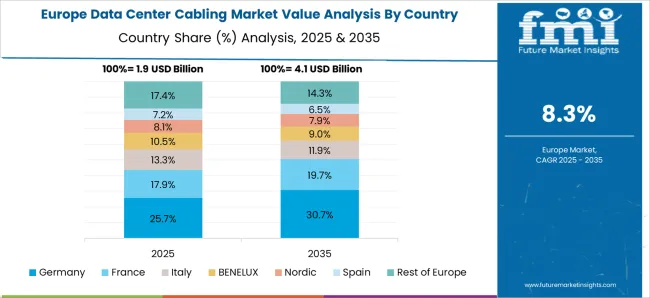
France presents steady expansion as Paris and Marseille host hubs that serve Southern and Western Europe. The CAGR for 2025–2035 is 9.3%, supported by cloud on-ramps, content delivery, and regulated workloads that favor domestic facilities. Operators prioritize fiber-rich meet-me rooms and clean patching practices to preserve signal budgets as halls scale out. Growth in HPC and media transcoding has prompted wider adoption of low-loss assemblies and high-density panels to manage port counts without airflow penalties. Enterprises refreshing core networks continue to migrate plant to Category 6A or better for short-reach use, while data halls lean decisively toward single-mode and ribbon constructions that simplify mass terminations.
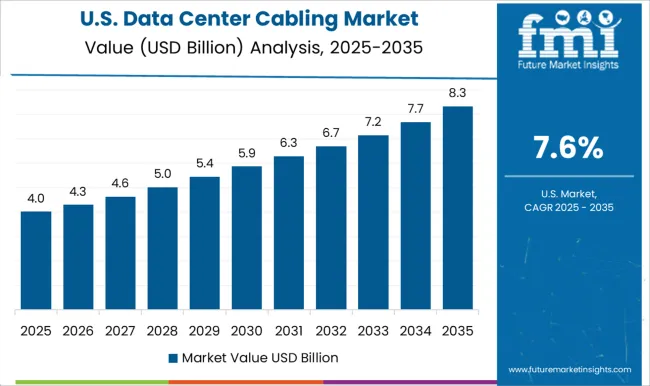
The United States exhibits a mature pattern, with expansions concentrating in major corridors such as Northern Virginia, Dallas, and Phoenix. The CAGR for 2025–2035 is 7.6%, driven by retrofit programs and selective new builds tied to AI clusters and cloud availability zones. Procurement emphasizes migration-ready fiber, stringent acceptance testing, and lifecycle cost control. Colocation providers seek pre-engineered trunks that accelerate tenant fit-outs and reduce rework. Even with strong scale, growth remains measured due to efficient reuse of pathways and disciplined capital allocation. Vendors that bundle design support, labeling systems, and warranty coverage gain traction as operators prioritize uptime, clean documentation, and predictable turn-up of high-bandwidth links.
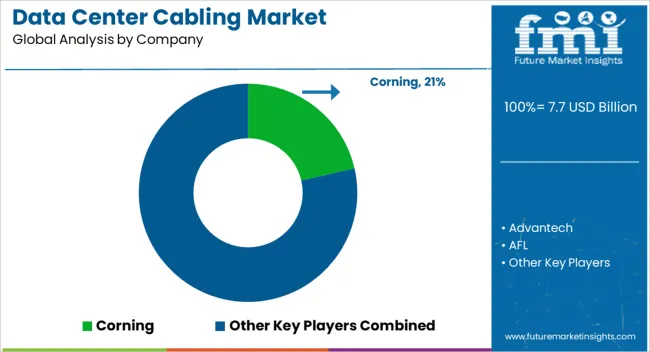
The data center cabling market is characterized by strong global players alongside specialized providers that drive innovation in connectivity solutions. Corning leads with its advanced optical fiber products, enabling high-performance data transmission in hyperscale and enterprise facilities. Advantech focuses on integrating industrial networking and cabling infrastructure, offering tailored solutions for edge data centers.
AFL is recognized for its fiber optic cable and connectivity systems, supporting large-scale deployments with high bandwidth requirements. Belden has established its presence through copper and fiber cabling products designed for secure, reliable data transmission. CommScope remains a key competitor with a broad cabling portfolio, including high-density fiber systems and pre-terminated solutions widely used in colocation facilities.
Furukawa Electric emphasizes optical connectivity products, offering innovation in bend-insensitive fiber and cabling for high-speed data transfer. Legrand focuses on structured cabling, delivering modular and scalable solutions for enterprise and cloud environments. Leviton provides copper and fiber systems known for high reliability, especially in enterprise and commercial data center segments. Panduit brings expertise in structured cabling design, particularly with modular, pre-terminated assemblies that reduce installation time and improve operational efficiency.
Siemon is recognized for its high-performance structured cabling systems, often favored in enterprise and colocation builds. TE Connectivity holds a strong global presence with its fiber connectivity and cabling solutions, supporting operators in scaling data center capacity efficiently.
Differentiation in this competitive environment is shaped by advancements in optical fiber technology, modular cabling assemblies, and scalable designs that ensure low-latency performance. Leading players focus on enhancing system reliability, simplifying installation, and integrating flexible solutions to meet the growing demand from hyperscale, enterprise, and edge data centers worldwide.
| Item | Value |
|---|---|
| Quantitative Units | USD 7.7 Billion |
| Product | Fiber optic cables and Copper cables |
| Wire Category | 6A, 5E, 6, 7, and Others |
| Component | Cables, Connectors, Accessories, and Others |
| End Use | Hyperscale data center, Colocation data center, Enterprise data centers, and Cloud service providers |
| Application | Data transfer and networking, Power distribution, and Cable management and organization |
| Regions Covered | North America, Europe, Asia-Pacific, Latin America, Middle East & Africa |
| Country Covered | United States, Canada, Germany, France, United Kingdom, China, Japan, India, Brazil, South Africa |
| Key Companies Profiled | Corning, Advantech, AFL, Belden, Commscope, Furukawa Electric, Legrand, Leviton, Panduit, Siemon, and TE Connectivity |
| Additional Attributes | Dollar sales, share, regional demand growth, fiber vs copper adoption, pricing benchmarks, competitor positioning, hyperscale investments, regulatory impact, and upgrade cycles. |
The global data center cabling market is estimated to be valued at USD 7.7 billion in 2025.
The market size for the data center cabling market is projected to reach USD 18.1 billion by 2035.
The data center cabling market is expected to grow at a 8.9% CAGR between 2025 and 2035.
The key product types in data center cabling market are fiber optic cables and copper cables.
In terms of wire category, 6a segment to command 38.5% share in the data center cabling market in 2025.






Full Research Suite comprises of:
Market outlook & trends analysis
Interviews & case studies
Strategic recommendations
Vendor profiles & capabilities analysis
5-year forecasts
8 regions and 60+ country-level data splits
Market segment data splits
12 months of continuous data updates
DELIVERED AS:
PDF EXCEL ONLINE
Data Acquisition Hardware Market Size and Share Forecast Outlook 2025 to 2035
Data Discovery Market Size and Share Forecast Outlook 2025 to 2035
Data Masking Technology Market Size and Share Forecast Outlook 2025 to 2035
Data Centre Rack Server Market Size and Share Forecast Outlook 2025 to 2035
Data Business in Oil & Gas Market Size and Share Forecast Outlook 2025 to 2035
Data Centre Colocation Market Size and Share Forecast Outlook 2025 to 2035
Data Lake Market Size and Share Forecast Outlook 2025 to 2035
Data Lakehouse Market Size and Share Forecast Outlook 2025 to 2035
Data Centre UPS Market Size and Share Forecast Outlook 2025 to 2035
Data-Driven Retail Solution Market Size and Share Forecast Outlook 2025 to 2035
Data Science Platform Market Size and Share Forecast Outlook 2025 to 2035
Data Monetization Platform Market Size and Share Forecast Outlook 2025 to 2035
Data Conversion Services Market Size and Share Forecast Outlook 2025 to 2035
Data Exfiltration Market Size and Share Forecast Outlook 2025 to 2035
Data Virtualization Cloud Market Analysis – Growth & Forecast 2025 to 2035
Data Management Platforms Market Analysis and Forecast 2025 to 2035, By Type, End User, and Region
Data Fabric Market Analysis - Trends, Size & Forecast 2025 to 2035
Data Warehouse as a Service Market - Cloud Trends & Forecast 2025 to 2035
Data Catalog Market Trends - Growth & Forecast 2025 to 2035
Data as a Service (DaaS) Market Analysis by Pricing Model, Deployment Type, End User, and Region Through 2035

Thank you!
You will receive an email from our Business Development Manager. Please be sure to check your SPAM/JUNK folder too.
Chat With
MaRIA